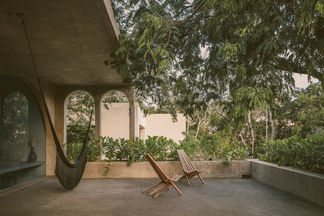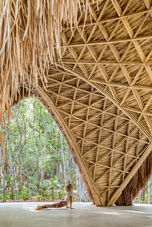
February 2025 | DESIGN & INTERIORS
JOANA & JOSHUA’s ECO-CONSCIOUS VISION
words Onur Baştürk
They prioritize eco-conscious design and refuse to take on projects that threaten sensitive ecosystems. For them, sustainability is more than just a buzzword; it’s a core value. They also incorporate handmade elements that bring depth and texture to their work, favoring these over mass-produced, soulless perfection. I’m referring to Joana Gomes and Joshua Beck. Are you ready for an inspiring conversation with the duo who founded CO-LAB in Tulum, Mexico in 2010, and quickly brought their vision of biophilic architecture to life?










Joana and Joshua, how did you meet and how did you decide to found CO-LAB?
We first met in Rotterdam - Joana was working at MVRDV and Joshua at OMA. Our first collaborations on design competitions quickly showed how our shared values - especially in sustainability, design and craftsmanship - complemented each other. As our personal relationship grew, we realized that we enjoyed working together and saw an opportunity to bring our ideas to life through a collaborative practice. What began as a few collaborations naturally evolved into the founding of CO-LAB. Our goal was to create a design studio that combines environmental consciousness with artistry, and modern design with handcrafted elements. We aim to make architecture not only functional, but also emotionally resonant, deepening the connection between people, space and nature.
Is there a specific reason why you chose Tulum as the location for CO-LAB? By the way, you also had a plan to open a CO-LAB office in Costa Rica. Did it open?
Tulum was an ideal choice for us because of its raw, natural beauty - a perfect setting for developing designs that are in harmony with nature. It allowed us to fully explore our vision of creating sustainable, biophilic architecture. The landscape, climate, and local materials provided a unique canvas for our work. As for Costa Rica, the plan is still a work in progress. Given Costa Rica's strong commitment to environmental sustainability and its rich biodiversity, it fits perfectly with CO-LAB's philosophy; we are working on some projects there, but the office hasn't opened yet.
What is your division of labor? Are your ideas and dreams mostly the same, or do you create projects with different ideas?
We are both actively involved in every phase of a project, especially during the conceptual stages. Our diverse ideas enrich the creative process and encourage us to explore various possibilities, leading to more refined and cohesive designs. This dynamic exchange enables us to create spaces that are both functional and shaped by different perspectives.
What do you think are the 3 most important characteristics of CO-LAB?
1. Integration with Nature: Our designs aim to bring the beauty of outdoor spaces into indoor environments, allowing for a deeper, more meaningful connection with nature. We believe that incorporating natural elements into everyday life has a profound effect on well-being, fostering a deeper appreciation for the environment and motivating a stronger desire to protect it.
2. Artisanal Craftsmanship: In reaction to perfect mass-produced, soulless objects, we embrace handcrafted elements that bring depth and texture to our projects. The true beauty of a space lies in the subtle imperfections and marks left by human hands. This interaction between maker and material infuses a building with energy, making it feel more authentic, alive, and emotionally engaging.
3. Sustainability: We always prioritize eco-conscious design. We decline projects that compromise sensitive ecosystems and choose eco-friendly materials whenever possible. While we do use concrete in our Tulum projects due to the hurricane zone, we view this as a necessary balance between durability and sustainability. For us, sustainability is more than just material choices - it is a commitment to respect and protect the environment through mindful design.
VILLA PETRICOR
IN TODAY’S FAST-PACES WORLD, THE CONNECTION TO NATURE IS CRUCIAL, AS PEOPLE SEEK SPACES THAT PROVIDE OPENNESS, TRANQUILITY, AND NATURAL LIGHT





LUUM TEMPLE
The use of fluid transitions between interior and exterior spaces has increased in recent projects. You did this long before with the Villa Petricor project. Do we want to feel nature and natural light more now, what do you think?
Absolutely. In today’s fast-paced world, the connection to nature is crucial, as people seek spaces that provide openness, tranquility, and natural light. Villa Petricor was an exploration of this principle, and we've continued to integrate these ideas into all of our projects. We believe the desire for biophilic design is growing because, deep down, we all crave a connection to nature. It offers not only aesthetic pleasure, but also emotional restoration.
What are the common features of your projects so far?
First, a strong connection to the environment. A direct relationship with the landscape, using operable windows, courtyards and other design elements to bring the outside in.
Second, a minimalist yet organic aesthetic. Clean lines combined with natural, textural elements that reflect the raw beauty of the materials. The third is sustainability. From sourcing local materials and artisans to using energy-efficient systems, sustainability is at the heart of everything.
What are the advantages and disadvantages of living and working in Tulum?
Living in Tulum offers the incredible advantage of being immersed in nature, which continuously fuels our creativity. The pace of life is slower, which allows us to reflect deeply on our work and think more holistically about design. However, the logistical challenges can be significant—access to materials and infrastructure is often limited, which means we have to be resourceful and adaptive. But these challenges also drive innovation, pushing us to work closely with local artisans and craftsmen, enhancing the authenticity of our projects.
What other projects are you working on at the moment, especially your latest project in the Seychelles?
The Seychelles project is designed to celebrate the natural beauty of the island while embracing sustainability. We're using locally sourced materials and designing in harmony with the landscape to minimize environmental impact. We are also working on several other projects, including a large residence in India, a house in Jamaica, a house in Costa Rica, and several projects in Mexico. We love working in different regions as it allows us to research and experiment with local techniques, materials and cultural contexts.
I'm curious about what inspires you both - it could be anything.
JOANA: I find endless inspiration in nature - organic shapes, textures and the way light interacts with the environment. Whether it's the intricate patterns in leaves or the flow of water, these elements influence how I approach design. I'm also inspired by ancient architecture, especially structures that have stood the test of time and feel deeply connected to their surroundings.
JOSHUA: I am inspired by spending time in nature. I enjoy long swims in the ocean, visiting different coral reefs and marveling at the complexity and creativity of natural forms-it never ceases to amaze me. Another source of inspiration is our almost 3-year-old daughter, who is the most incredible human being.








CASA TEPUI

